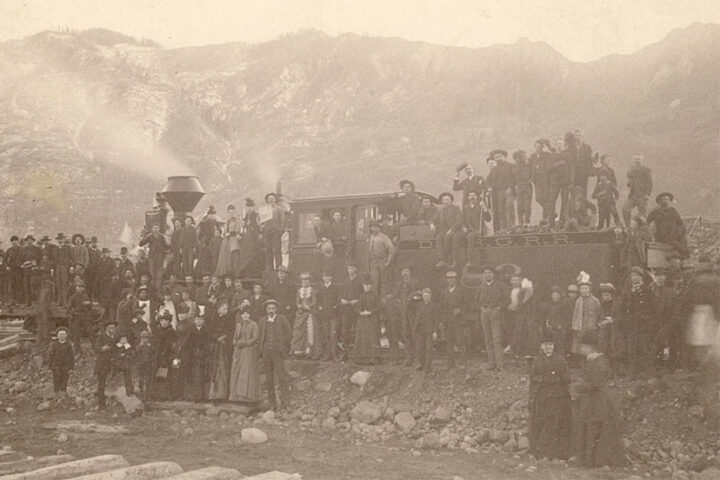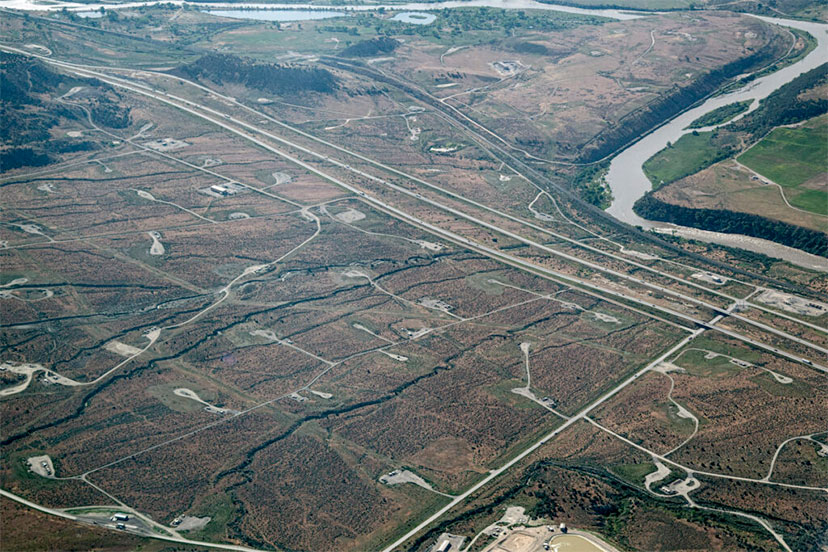PHOTO: Gas wells operate in Garfield County near Interstate 70 and Parachute, June 9, 2023. (William Woody for Colorado Newsline)
This article series by Chase Woodruff appeared on Colorado Newsline beginning on June 26, 2023.. We are sharing it in multiple parts.
U.S. Senator John Hickenlooper, a Democrat and former petroleum geologist, has long been an ally of Colorado oil and gas producers, embittering many in his own party who accused him of siding with the industry throughout his time as governor, which overlapped with unprecedented boom times for drillers in the Piceance and Denver-Julesburg basins.
Though he’s hardly been an outspoken opponent of the project itself, Hickenlooper in March joined other Colorado Democrats in objecting to the railway’s plans to seek financing through Private Equity Bonds (PABs).
“While we support boosting domestic energy production for the benefit of American consumers and our allies abroad, private-sector investments should be based on consumer demand where they pertain to mature technologies with existing, robust markets,” Hickenlooper and his colleagues wrote in a letter to Transportation Secretary Pete Buttigieg. “There is no precedent for using PABs to fund a rail project solely to transport crude oil.”
Mile 86: Rulison
The signs for Rulison, seven miles east of Parachute, direct passersby to a sparse patchwork of small farms and pastures at the foot of the Grand Mesa to the south.
It was at a spot hidden high on one of these hills where, in August 1969, men in hard hats carefully lowered a long, thin canister down a hole drilled a mile and a half deep into the Earth, penetrating a thick underground rock layer that kept a large reserve of natural gas trapped further below.
A few weeks later, crews triggered the device inside the canister: a 40-kiloton nuclear bomb.
The blast from “Project Rulison” toppled chimneys and cracked foundations in Rifle and Parachute, and shook the ground as far away as Golden. It was one of the few instances ever in which the federal government, in partnership with the oil and gas industry, tried fracking with nukes. The method was soon abandoned, because — surprise, surprise — the gas produced as a result of the explosions proved too radioactive to be marketable.
These days, the thing most likely to rattle windows in the Colorado River Valley is freight traffic on the railroad, which passes directly through almost all of Garfield County’s towns — small communities of a few thousand people each, where tracks were laid almost a century and a half ago, along main streets and town squares. In many places, trains pass just yards away from homes and businesses, often at high speeds.
Even when the fracking isn’t being done with nuclear bombs, the fossil fuel economy brings with it benefits and risks — and rarely, if ever, are they evenly distributed. In the case of the Uinta Basin oil trains, many of the risks of increased production would be shouldered by communities in this valley, while almost all of the benefits would accrue to producers, mineral owners and county governments a hundred miles away in Utah.
“This train is not bringing anything to this area,” said Caitlin Carey, a Town Council member in New Castle. “It’s not taking crude from Garfield County, or Mesa County, or Moffat County. It’s taking Utah crude on a scenic trip to a refinery in Louisiana.”
But the oil and gas industry wields power here, and the jobs and flush bank accounts that the gas boom provided remain an important part of the county’s economy and self-image. And in a country where local politics have become increasingly nationalized, small-town safety concerns aren’t the only thing being debated.
Though Boebert has been an outspoken critic of the Biden administration over the February chemical spill caused by a train derailment in East Palestine, Ohio, she has remained silent on a proposal that could drastically increase the amount of hazardous materials shipped by rail through the heart of her district. A Boebert spokesperson declined to comment on the record regarding her position on the Uinta Basin Railway.
“We’ve had citizens’ comments and so forth, but we haven’t spent time on it, and I don’t think it’s our business to spend time on it,” Garfield County Commissioner Tom Jankovsky said. “It seems like people are making a big deal out of something that’s not such a big deal.”
In March, Garfield’s Board of County Commissioners brushed aside concerns about the oil trains. Commissioner Mike Samson faulted local opponents for “fear-mongering” and railed against what he called the “disaster” of the Biden administration’s energy policy. The response stunned New Castle residents and officials who’d come to the commission with their concerns.
“We have the most residents in close proximity to the rail line,” Carey said.
“The problem isn’t oil and gas altogether,” she added. “The problem is that this is a high-speed train coming through with a payload that is toxic in some situations, and deadly in others. That shouldn’t be something that is politicized.”
Though its gold-rush days are the stuff of legend, it was the silver boom that followed that did more to make Colorado what it is today.
During the 1880s, settlements promising the next silver bonanza sprang up all over the mountains, especially after the Ute people were dispossessed of their lands on the Western Slope. With each new boomtown — Leadville, Aspen, Silverton, Ouray, Creede — Colorado railroad companies raced to be the first to connect them with the outside world. Backed by enterprising local mine owners or Eastern financiers, competing railroads warred over trackage rights and frantically added new branches and spurs to their “mainline” systems, grading out the canyon trails and mountain passes that would become permanent features of the state’s transportation infrastructure.
After completing its narrow-gauge line through Grand Junction to Salt Lake City in 1883, the Denver & Rio Grande Railway Company battled the newly founded Colorado Midland Railway to build the first route into the Roaring Fork Valley’s booming Aspen mining district. While the Midland struggled with a more direct route over the mountains from Leadville, the Denver & Rio Grande turned north, laying the first-ever tracks along the old burro trails of the central Colorado River Valley, then turned south again at Glenwood Springs to follow the course of the Roaring Fork.
When the Denver & Rio Grande reached Aspen three months ahead of its rival, the official celebrations lasted a week. Six hundred rail workers were treated to a giant barbecue, and the first train to arrive, on Nov. 1, 1887, carried Gov. Alva Adams and U.S. Sen. Henry Teller as passengers, among other dignitaries.

“Our mines have been practically idle, waiting the coming of the iron horse,” Aspen Mayor Herbert Harding said in a welcoming address. “We are now entering upon an era of prosperity that will be unprecedented in our history.” (In fact, within six years the silver boom would be over for good, brought to an end by the Panic of 1893 and repeal of federal silver-coinage policies.)
But the railroads were more than just highways for heavy industry, and even for towns that weren’t founded on mining, the arrival of the iron horse was a signal event. A month before tracklayers from the Denver & Rio Grande reached Aspen, their arrival in the resort community of Glenwood Springs was greeted with fireworks, a parade and a lavish banquet at the Hotel Glenwood. It was the same a few years later in New Castle, Rifle and other small settlements in the Colorado River Valley, as a subsidiary of the Denver & Rio Grande laid track to connect its Aspen Branch to Grand Junction, completing the right-of-way that trains still travel today between the state line and the east end of Glenwood Canyon.
Even in the golden age of railroading, passenger service was a loss leader for most railroad companies, subsidized by the more lucrative business of hauling freight, said Paul Hammond, director of the Colorado Railroad Museum in Golden.
“By the late 19th century, freight traffic is what’s making the money,” Hammond said. “Passenger travel is something that is offered as a public good, and as a marketing awareness tool.”
But especially in parts of western Colorado where road and highway networks were slow to develop, railroads became a vital service connecting towns across rugged terrain, and stayed that way for generations.
In 1914, trains on the Denver & Rio Grande made 16 stops between Grand Junction and Glenwood Springs. From Main Street in New Castle, a passenger could step onto a train and step off a short while later onto the Main Street of every town that still exists in the valley today, and many that don’t: Akin, Morris, Lacy, Ives, Chacra. For most of the first half of the 20th century, there were two local Denver & Rio Grande passenger trains each way daily.
“You could go down (to Glenwood Springs) in the morning and come back in the evening,” an old-timer told journalist Conrad Schrader in 1996. The Denver & Rio Grande’s long-haul California Zephyr began operations in 1949, and continued as the country’s last independent intercity passenger line until 1983.
After merging with the Southern Pacific Railroad in the 1980s, the Denver & Rio Grande was acquired by the Union Pacific in 1996. But affection for the “Action Road” lives on at the Colorado Railroad Museum, which houses some of its iconic locomotives and rolling stock, and in a dedicated community of local “railfans” who help keep its history alive.
Carl Smith, a third-generation railroader whose father and grandfather worked on the Denver & Rio Grande, is no railfan — “I like trains on payday,” he said — but he’s seen first-hand the effects of rail industry consolidation in Colorado.
“The local supervisors, managers, officials, they had connections to the community,” said Smith, the Colorado legislative director for the International Association of Sheet Metal, Air, Rail and Transportation Workers, or SMART. “Now it’s just turned into this large beast, and nobody even knows who the person to call is in case of emergency.”

